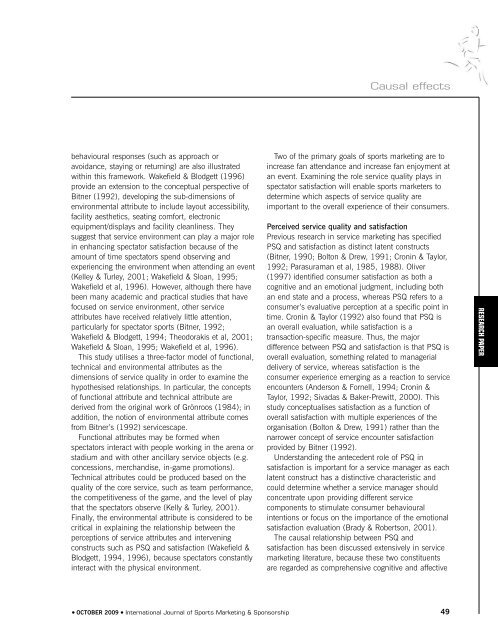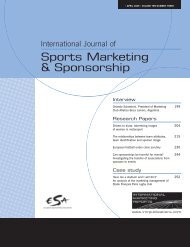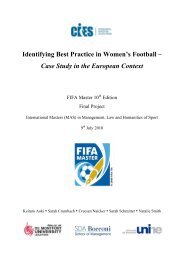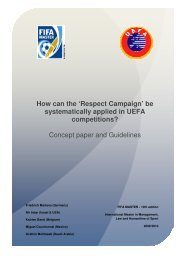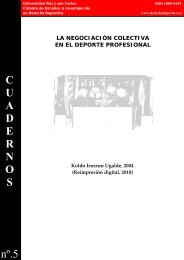Sports Marketing & Sponsorship - FIFA/CIES International University ...
Sports Marketing & Sponsorship - FIFA/CIES International University ...
Sports Marketing & Sponsorship - FIFA/CIES International University ...
- No tags were found...
You also want an ePaper? Increase the reach of your titles
YUMPU automatically turns print PDFs into web optimized ePapers that Google loves.
Causal effectsbehavioural responses (such as approach oravoidance, staying or returning) are also illustratedwithin this framework. Wakefield & Blodgett (1996)provide an extension to the conceptual perspective ofBitner (1992), developing the sub-dimensions ofenvironmental attribute to include layout accessibility,facility aesthetics, seating comfort, electronicequipment/displays and facility cleanliness. Theysuggest that service environment can play a major rolein enhancing spectator satisfaction because of theamount of time spectators spend observing andexperiencing the environment when attending an event(Kelley & Turley, 2001; Wakefield & Sloan, 1995;Wakefield et al, 1996). However, although there havebeen many academic and practical studies that havefocused on service environment, other serviceattributes have received relatively little attention,particularly for spectator sports (Bitner, 1992;Wakefield & Blodgett, 1994; Theodorakis et al, 2001;Wakefield & Sloan, 1995; Wakefield et al, 1996).This study utilises a three-factor model of functional,technical and environmental attributes as thedimensions of service quality in order to examine thehypothesised relationships. In particular, the conceptsof functional attribute and technical attribute arederived from the original work of Grönroos (1984); inaddition, the notion of environmental attribute comesfrom Bitner’s (1992) servicescape.Functional attributes may be formed whenspectators interact with people working in the arena orstadium and with other ancillary service objects (e.g.concessions, merchandise, in-game promotions).Technical attributes could be produced based on thequality of the core service, such as team performance,the competitiveness of the game, and the level of playthat the spectators observe (Kelly & Turley, 2001).Finally, the environmental attribute is considered to becritical in explaining the relationship between theperceptions of service attributes and interveningconstructs such as PSQ and satisfaction (Wakefield &Blodgett, 1994, 1996), because spectators constantlyinteract with the physical environment.Two of the primary goals of sports marketing are toincrease fan attendance and increase fan enjoyment atan event. Examining the role service quality plays inspectator satisfaction will enable sports marketers todetermine which aspects of service quality areimportant to the overall experience of their consumers.Perceived service quality and satisfactionPrevious research in service marketing has specifiedPSQ and satisfaction as distinct latent constructs(Bitner, 1990; Bolton & Drew, 1991; Cronin & Taylor,1992; Parasuraman et al, 1985, 1988). Oliver(1997) identified consumer satisfaction as both acognitive and an emotional judgment, including bothan end state and a process, whereas PSQ refers to aconsumer’s evaluative perception at a specific point intime. Cronin & Taylor (1992) also found that PSQ isan overall evaluation, while satisfaction is atransaction-specific measure. Thus, the majordifference between PSQ and satisfaction is that PSQ isoverall evaluation, something related to managerialdelivery of service, whereas satisfaction is theconsumer experience emerging as a reaction to serviceencounters (Anderson & Fornell, 1994; Cronin &Taylor, 1992; Sivadas & Baker-Prewitt, 2000). Thisstudy conceptualises satisfaction as a function ofoverall satisfaction with multiple experiences of theorganisation (Bolton & Drew, 1991) rather than thenarrower concept of service encounter satisfactionprovided by Bitner (1992).Understanding the antecedent role of PSQ insatisfaction is important for a service manager as eachlatent construct has a distinctive characteristic andcould determine whether a service manager shouldconcentrate upon providing different servicecomponents to stimulate consumer behaviouralintentions or focus on the importance of the emotionalsatisfaction evaluation (Brady & Robertson, 2001).The causal relationship between PSQ andsatisfaction has been discussed extensively in servicemarketing literature, because these two constituentsare regarded as comprehensive cognitive and affectiveRESEARCH PAPER● OCTOBER 2009 ● <strong>International</strong> Journal of <strong>Sports</strong> <strong>Marketing</strong> & <strong>Sponsorship</strong>49


